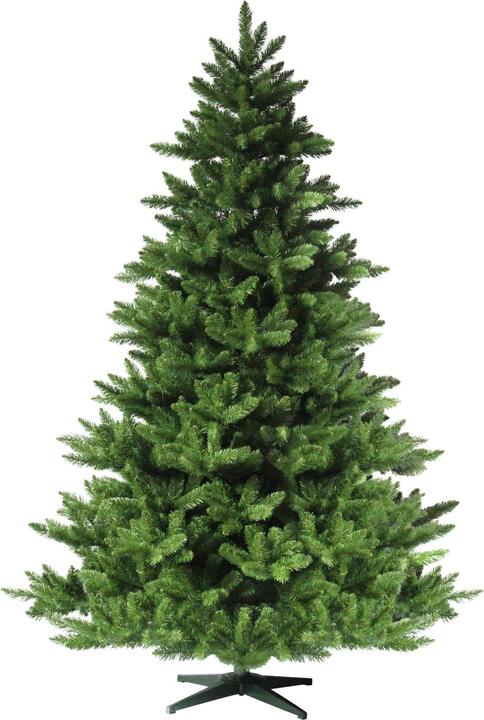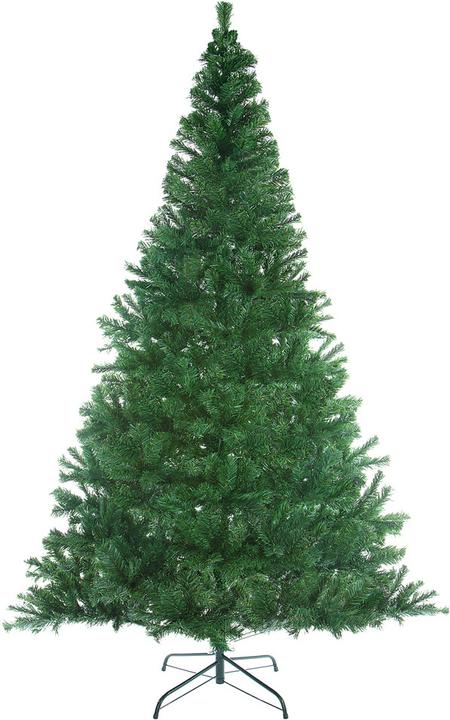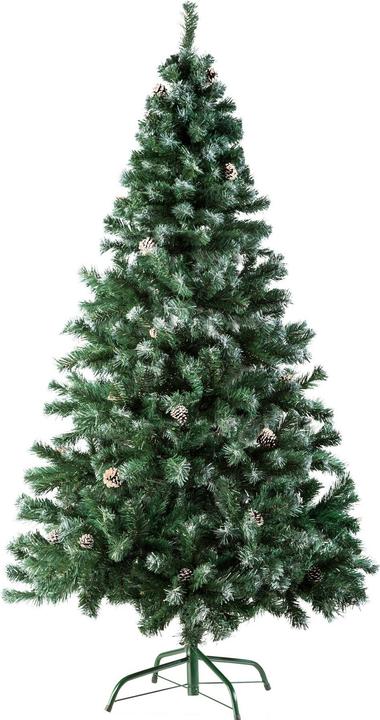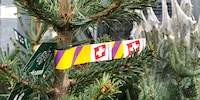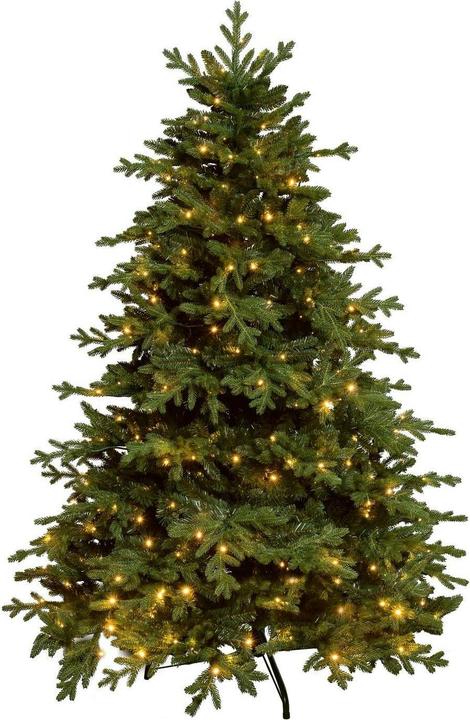
From poor pines to shockingly real: a comparison of artificial Christmas trees
Fed up with needle Christmas trees that you constantly have to water? An artificial tree could be the solution. We compared and rated four differently priced models.
Our test trees are between 150 and 180 centimetres tall, sizing that allows the trees to fit even into small flats. Their prices range from just under 30 to over 200 francs, with the most expensive model also including lights. But we aren’t blinded by this, evaluating objectively using these categories:
- Material and origin
- Putting up and taking down
- Authenticity
We’ve awarded a maximum of five Christmas trees for each category 🎄. All categories are weighted equally. In the end, the model with the most little trees wins.
The competitors
These are our test candidates, all ordered from our shop or marketplace retailers:
STT Christmas tree
At CHF 220, this tree is the most expensive of the bunch as well as the heaviest, coming in at just under ten kilos. At 150 centimetres, it isn’t particularly tall. A string of 290 LEDs is already mounted, and a Christmas tree stand included.

RS Trade Christmas tree
The RS Trade tree, which costs 120 francs, has the model designation HXT 19001. It’s around 150 centimetres tall, sprouting 872 PVC needles – apparently, we haven’t counted. A metal Christmas tree stand is included in the packaging.
Casaria Christmas tree
At 30 francs, this 150-centimetre Christmas tree from Casaria is the cheapest model in our test. Despite the low price, a metal stand is also included.
Tectake Christmas tree
It’s the best-selling artificial Christmas tree on Galaxus. At 180 centimetres, it’s also the tallest in our test. It sports a total of 705 PVC needles and even pine cones on its branches. Once again, a stand is included.
But now onto the test categories. After all, we don’t want to miss the forest for the trees with all this preamble.
Materials and origin
Artificial Christmas trees generally consist of a metal structure supporting individual branches, which in turn split into twigs. The needles are either made of cut PVC film wrapped around a bendable wire or they were manufactured from polyethylene (PE) using an injection moulding process.
Among our test trees, only the most expensive model has branches and needles made of PE. The other three models rely on a much cheaper manufacturing process, namely PVC film cut into a needle shape. The Tectake tree also has white-coloured tips and varnished real pine cones as decorative elements.
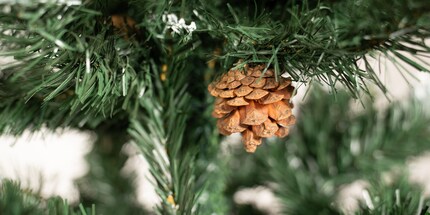
No manufacturer provides any detailed information on the material used. This means that recycled plastic almost certainly hasn’t been used, for example. It seems no particular emphasis was placed on the recyclability of the trees during production.
Rating
- STT: 🎄🎄
- RS Trade: 🎄
- Casaria: 🎄
- Tectake: 🎄🎄
- Putting up and taking down
Three out of the four trees use the same stand. It’s a tubular metal thing, consisting of two bolted elements. These can be flattened for storage and placed at right angles to each other when setting up. The trunk of the tree is then fixed with eyebolts. The bigger the stand in regards to the weight of its tree, the more stable the whole set-up will be. Casaria’s tree is the least stable. With the STT and Tectake trees, it helps that they’re relatively heavy and therefore more stable.
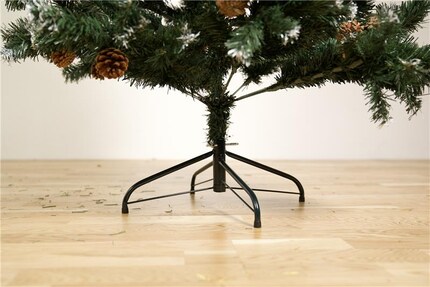
The RS Trade tree has a different stand; it’s more visually appealing than those thin steel tubes. In addition, the angle of the rubberised feet can be adjusted to compensate for slight unevenness on the floor.
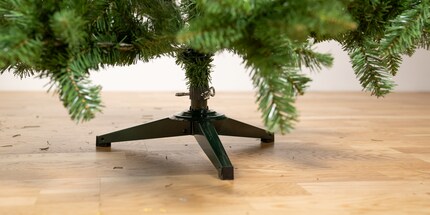
Fresh from the factory, all trees are packaged compactly. There are only two or three elements to plug together. Branches and twigs nestle close to the trunk and need to be unfolded and shaped by hand.
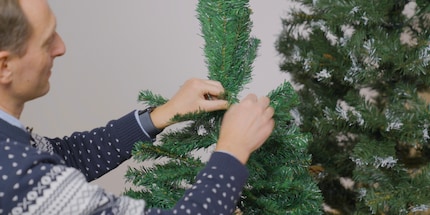
For the 30-franc Casaria tree, bend the wires downwards until they’re where you want them to be. You can then repeat the process for the branches bent around the twigs.
The STT, RS Trade and Tectake trees use a so-called umbrella mechanism for the lower branches. Here, the branches fold open with a kind of hinge. Further branching is also done by hand after that. You can also easily spend an hour bending each branch until the trees are as bushy as you’d like them to be. The injection-moulded branches of the STT tree are mostly already well formed. If you want to touch them up, they’re somewhat more difficult to shape than those with the cheap PVC films.
And after the holiday season? Well, the tree has to be stowed away again. None of them come with a bag, so save the box. But don't think you'll be able to put the tree back in the box as neatly as when you got it fresh from the factory. Even if you pack all the twigs tightly together again and fold up the branches, your artificial Christmas tree will take up a little more space. Only the RS Trade tree fits back into the box with a slight squeeze.
All in all, putting up and taking down don’t cause problems with any model, you don’t even need tools. Just a lot of patience to get the tree into the shape you want.
Rating
- STT: 🎄🎄🎄
- RS Trade: 🎄🎄🎄🎄
- Casaria: 🎄🎄
- Tectake: 🎄🎄🎄
Authenticity
Ideally, an artificial Christmas tree shouldn’t be recognisable as such. None of the trees tested managed the perfect illusion. Casaria’s cheap model looks very fake with its sparse branches and also has what feels like the thinnest needles.
STT’s priciest tree is at least partially convincing in terms of authenticity. It uses injection-moulded PE branches, and the needles on them look deceptively real. The STT tree isn’t made entirely from these high-quality branches; PVC cut branches are used inside and at the bottom to give the tree more fullness.
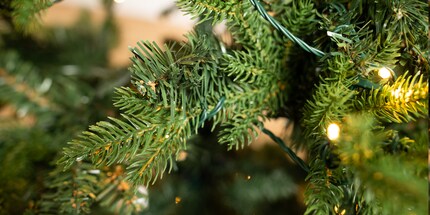
Only short-sighted people or anyone looking at the tree from three metres away will think the PVC film needles are real – even if the manufacturers aim to give the branches more authentic colour by using additional brown, shorter PVC films. Tectake directly counteracts these efforts with its white branch tips. What’s worse, the paint has also stuck together the foil needles at the front of the branches.
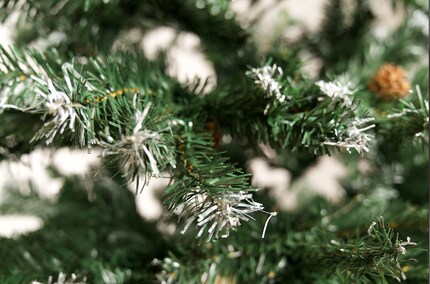
RS Trade, on the other hand, has come up with something that looks more real. Here, the PVC film strands aren’t simply cut smoothly, but shaped into a point. This is a small, but worthwhile additional step. The branches can also be fanned out easily and add some nice volume.
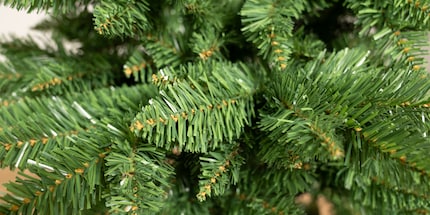
A look inside reveals all the trees to be fake – on none of them does the trunk even remotely look like a real one. The manufacturers simply wrap PVC needle strips around them to cover the metal. And the botanical fact that a tree trunk becomes thinner towards the top was ignored.
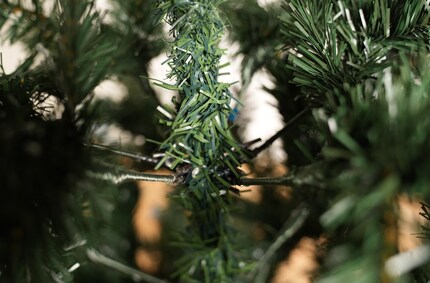
Rating
- STT: 🧹🧹🧹🧹🧹
- RS Trade: 🎄🎄🎄🎄
- Casaria: 🎄
- Tectake: 🎄🎄🎄
Verdict: more money, more realism
Sorry, there’s no crazy tip that’ll get you a beautiful fake Christmas tree for little money today. In comparison, the most expensive tree wins against its less pricy competition. Casaria’s cheapest tree lags behind significantly. I wouldn’t even put it in a dark corner.
For maximum authenticity, choose a tree where the branches and needles have been injection moulded. Only then will they look real up close. It’s why the STT model wins this test with 10 (out of a maximum possible 15) Christmas trees. In second place is the RS Trade model, scoring with a certain authenticity despite the PVC needles; in total, it gets 9 Christmas trees. Despite real pine cones, the Tectake tree only scores seven. Finally, Casaria comes in last place with four Christmas trees. Here’s what the resulting forest looks like:
- 🎄🎄🎄🎄🎄🎄🎄🎄🎄🎄– 1st place: STT
- 🎄🎄🎄🎄🎄🎄🎄🎄🎄 – 2nd place: RS Trade
- 🎄🎄🎄🎄🎄🎄🎄 – 3rd place: Tectake
- 🎄🎄🎄🎄 – 4th place: Casaria
Since an artificial Christmas tree provides both convenience and sustainability, I’d say it’s worth spending a little more money on one. After all, a tree like this will last at least a decade ideally.
You’ll find more information about artificial Christmas trees in the video above, including the highly dangerous flammability test. For English captions, go to Settings> Subtitles/CC> Auto-translate. If you have any questions about the models tested, please ask them in the comments. Have you had any good or bad experiences with artificial Christmas trees? Let the community know too!
In a nutshell
Almost feels real: the STT tree conquers our contest
Pro
- Looks real thanks to injection-moulded branches
- Stays in place thanks to weight
- Looks good overall
Contra
- Stand looks cheap
- Some branches aren’t made using the injection moulding process
Journalist since 1997. Stopovers in Franconia (or the Franken region), Lake Constance, Obwalden, Nidwalden and Zurich. Father since 2014. Expert in editorial organisation and motivation. Focus on sustainability, home office tools, beautiful things for the home, creative toys and sports equipment.
